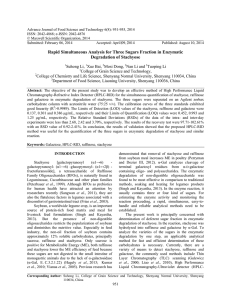Bacillus halodurans Andian Ari Anggraeni
advertisement
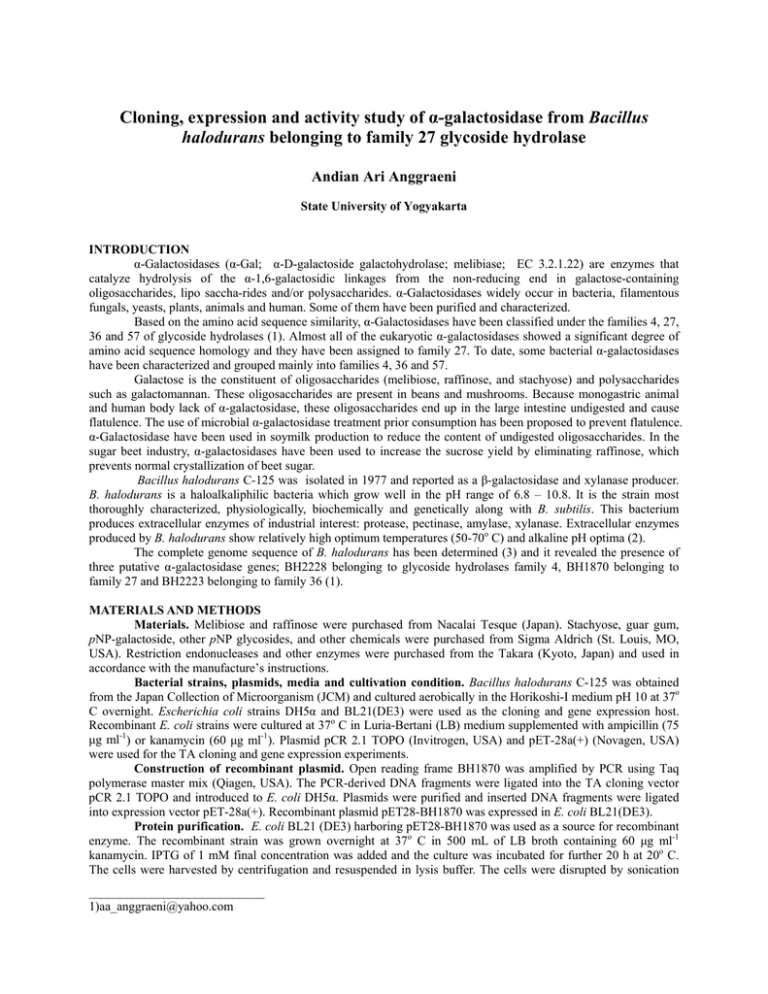
Cloning, expression and activity study of α-galactosidase from Bacillus halodurans belonging to family 27 glycoside hydrolase Andian Ari Anggraeni State University of Yogyakarta INTRODUCTION α-Galactosidases (α-Gal; α-D-galactoside galactohydrolase; melibiase; EC 3.2.1.22) are enzymes that catalyze hydrolysis of the α-1,6-galactosidic linkages from the non-reducing end in galactose-containing oligosaccharides, lipo saccha-rides and/or polysaccharides. α-Galactosidases widely occur in bacteria, filamentous fungals, yeasts, plants, animals and human. Some of them have been purified and characterized. Based on the amino acid sequence similarity, α-Galactosidases have been classified under the families 4, 27, 36 and 57 of glycoside hydrolases (1). Almost all of the eukaryotic α-galactosidases showed a significant degree of amino acid sequence homology and they have been assigned to family 27. To date, some bacterial α-galactosidases have been characterized and grouped mainly into families 4, 36 and 57. Galactose is the constituent of oligosaccharides (melibiose, raffinose, and stachyose) and polysaccharides such as galactomannan. These oligosaccharides are present in beans and mushrooms. Because monogastric animal and human body lack of α-galactosidase, these oligosaccharides end up in the large intestine undigested and cause flatulence. The use of microbial α-galactosidase treatment prior consumption has been proposed to prevent flatulence. α-Galactosidase have been used in soymilk production to reduce the content of undigested oligosaccharides. In the sugar beet industry, α-galactosidases have been used to increase the sucrose yield by eliminating raffinose, which prevents normal crystallization of beet sugar. Bacillus halodurans C-125 was isolated in 1977 and reported as a β-galactosidase and xylanase producer. B. halodurans is a haloalkaliphilic bacteria which grow well in the pH range of 6.8 – 10.8. It is the strain most thoroughly characterized, physiologically, biochemically and genetically along with B. subtilis. This bacterium produces extracellular enzymes of industrial interest: protease, pectinase, amylase, xylanase. Extracellular enzymes produced by B. halodurans show relatively high optimum temperatures (50-70o C) and alkaline pH optima (2). The complete genome sequence of B. halodurans has been determined (3) and it revealed the presence of three putative α-galactosidase genes; BH2228 belonging to glycoside hydrolases family 4, BH1870 belonging to family 27 and BH2223 belonging to family 36 (1). MATERIALS AND METHODS Materials. Melibiose and raffinose were purchased from Nacalai Tesque (Japan). Stachyose, guar gum, pNP-galactoside, other pNP glycosides, and other chemicals were purchased from Sigma Aldrich (St. Louis, MO, USA). Restriction endonucleases and other enzymes were purchased from the Takara (Kyoto, Japan) and used in accordance with the manufacture’s instructions. Bacterial strains, plasmids, media and cultivation condition. Bacillus halodurans C-125 was obtained from the Japan Collection of Microorganism (JCM) and cultured aerobically in the Horikoshi-I medium pH 10 at 37o C overnight. Escherichia coli strains DH5α and BL21(DE3) were used as the cloning and gene expression host. Recombinant E. coli strains were cultured at 37o C in Luria-Bertani (LB) medium supplemented with ampicillin (75 µg ml-1) or kanamycin (60 µg ml-1). Plasmid pCR 2.1 TOPO (Invitrogen, USA) and pET-28a(+) (Novagen, USA) were used for the TA cloning and gene expression experiments. Construction of recombinant plasmid. Open reading frame BH1870 was amplified by PCR using Taq polymerase master mix (Qiagen, USA). The PCR-derived DNA fragments were ligated into the TA cloning vector pCR 2.1 TOPO and introduced to E. coli DH5α. Plasmids were purified and inserted DNA fragments were ligated into expression vector pET-28a(+). Recombinant plasmid pET28-BH1870 was expressed in E. coli BL21(DE3). Protein purification. E. coli BL21 (DE3) harboring pET28-BH1870 was used as a source for recombinant enzyme. The recombinant strain was grown overnight at 37o C in 500 mL of LB broth containing 60 µg ml-1 kanamycin. IPTG of 1 mM final concentration was added and the culture was incubated for further 20 h at 20o C. The cells were harvested by centrifugation and resuspended in lysis buffer. The cells were disrupted by sonication ____________________________ 1)aa_anggraeni@yahoo.com and cell debris was removed by centrifugation. The supernatant was used as the crude enzyme solution and purified to homogeneity in a single step using HiTrap Chelating HP (Amersham) column chromatography. RESULTS AND DISCUSSION On the basis of nucleotide sequence of the putative putative α-galactosidase gene BH1870, primers were designed and the ORF BH1870 was cloned in pET-28a(+). Recombinant proteins were expressed in E. coli BL21(DE3). The translation product of B. halodurans BH1870 consists of 432 amino acids with a calculated molecular weight of 49 kDa. According to amino acid sequence similarity-based classification of glycoside hydrolases, BH1870 belongs to glycoside hydrolase family 27. This enzyme family contains oligosaccharidases with various specificities, i.e., α-galactosidase (EC 3.2.1.22), α-N-acetylgalactosaminidase (EC 3.2.1.49) and isomalto-dextranase (EC 3.2.1.94) (1). Protein purification was carried out using HiTrap Chelating HP (Amersham) column chromatography. SDS-PAGE revealed a protein band with a molecular mass of 49 kDa as shown in Figure 1. The value agrees with the calculated molecular mass. Purified protein showed low activity towards guar gum. The activity was indicated by the viscosity reduction of the guar gum solution after 10 minutes incubation at 37o C. Purified protein did not show any activity towards pNP-galactoside, melibiose, raffinose and stachyose. kDa 97 66 45 30 M 1 2 Fig. 1 : SDS-PAGE of purified recombinant protein. Lane M, protein molecular mass standard (molecular masses shown at the left); lane 1, crude extract; lane 2, purified protein. Based on substrate specificity, α-galactosidases can be classified into two groups; i.e., one group is specific for small saccharides such as pNP-galactoside, melibiose, raffinose and stachyose, and the other group can liberate galactose from highly polymerized galactomannans such as guar gum in addition to small molecular mass substrates. Most of eukaryotic α-galactosidases from family 27 glycoside hydrolase generally specific to highly polymerized galactomannans in addition to small substrate, whereas prokaryotic α-galactosidases prefer small substrates. In this context, this enzyme also prefers highly polymerized galactomannans. REFERENCES 1. Henrissat, B. and Coutinho, P. Glycosyl hydrolase families. Architecture et Fonction des Macromoléules Bioloques, NRS, Marseille, France, http://afmb.cnrs-mrs.fr/~cazy/CAZY/index.html 2. Takami, H. and Horikoshi, K. 2000. Analysis of the genome of an alkaliphilic Bacillus strain from an industrial point of view. Extremophiles 4:99-108 3. Takami, H., Nakasone, K., Takaki, Y., Maeno, G., Sasaki, R., Masui, N., Fuji, F., Hirama, C., Nakamura, Y., Ogasawara, N., Kuhara, S. and Horikoshi K. 2000. Complete genome sequence of the alkaliphilic bacterium Bacillus halodurans and genomic sequence comparison with Bacillus subtilis. Nucleic Acids Res. 28:4317-4331 ____________________________ 1)aa_anggraeni@yahoo.com
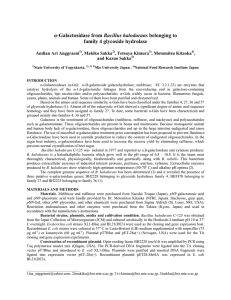
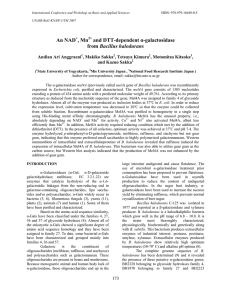
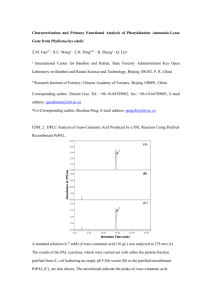
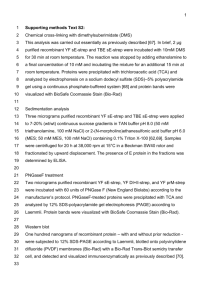
![Anti-TECK antibody [MM0150-9G99] ab89541 Product datasheet Overview Product name](http://s2.studylib.net/store/data/012488265_1-da83911d2ea4ec9af70b03983eb05f60-300x300.png)
